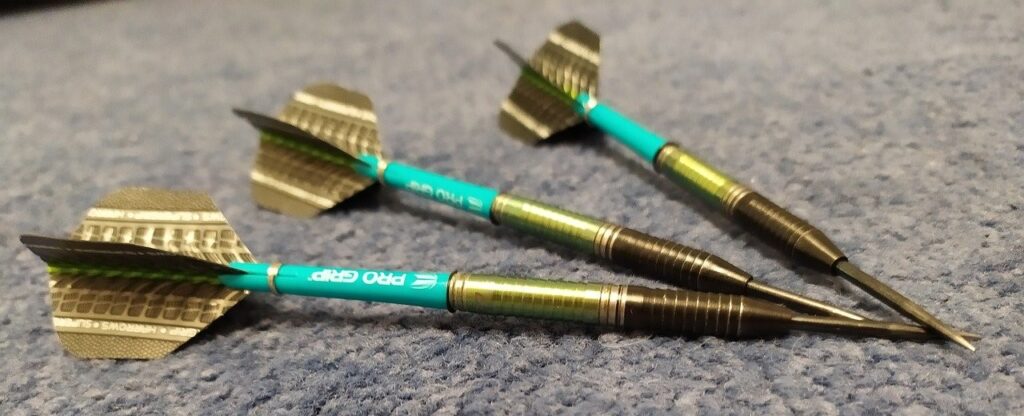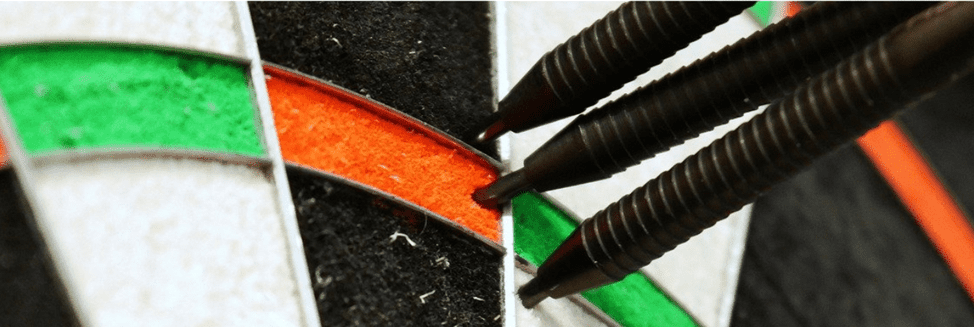Only darts that are touching the surface of the board at the end of a set of throws will score points, so it goes without saying that making sure your darts a) hit the board, and b) stay in the board, are two essentials. There are two common problems players can face here:
- Bounce-outs
- Darts not sticking in the board properly and falling out.
Bounce-outs happen instantly when the darts come into contact with the board, but sometimes darts may stick in the board briefly and then drop out which can be a bit painful to watch (problem #2).
In this article, I’ll explain why these two issues occur and give you plenty of tips to prevent them so you end up scoring more points per throw!
The Quick Answer
To stop your darts falling and bouncing out of the board, scuff your points using sandpaper and make sure they are sharp. Using heavier darts and a harder throw will also make sure the darts stay in the board. Also, make sure you’re using a dartboard with thin wires and stiff bristles.

Why Do Bounce-Outs Happen?
Bounce-outs in darts happen when an incoming dart hits either the wiring or staples on the board, or another dart that is already in the board. More commonly, the bounce-outs occur due to collision with the metal wiring which causes them to ricochet off the board and onto the floor resulting in 0 points.
Bounce-outs can occur due to the way you throw the dart, due to an issue with the shape of the point on your darts or due to the design of your board.
Common Causes of Bounce-Outs:
- Thick wiring and staples on the dartboard
- Blunt or overly sharp dart points
- Throwing the dart too softly
- The darts are very light
- Collisions with other darts on the board
How to Prevent Bounce-Outs
Bounce-outs are common in darts and are inevitable, but there are a few things you can do the reduce their frequency.
The easiest way to prevent bounce-outs is to sharpen your darts, as blunt darts are more likely to bounce out of the board. Using heavier darts and throwing them with more force is also likely to reduce the frequency of bounce-outs as the dart is more likely to penetrate the bristles.
There are three aspects you can target you reduce the chance of bounce-outs:
- The darts themselves
- Your throwing technique
- The dartboard
Let’s take a look at each method of reducing bounce-outs in some detail.
Sharpen the Dart Points
If you’re experiencing bounce-outs frequently, then check how sharp your points are. They should look visibly quite sharp and if you see that it’s very rounded, then it’s time to sharpen them. The best way to sharpen dart points is using a sharpening stone which you can find here on Amazon. You simply place the point inside the stone and rotate it around 10 times before checking the point.
It’s also important though that the dart points are not too sharp. When the points are needle sharp, this can actually lead to more bounce-outs because they will make an impression when they hit the wiring and then bounce out. However, slightly rounded points tend to slide past the wiring more easily rather than penetrate it.
Dart Point Sharpener (image links to Amazon)
Replace the Dart Points
If the tips on your dart are damaged beyond repair or are wonky, then it’s time to replace them as they’ll often result in bounce-outs through no fault of the player or the board. Soft-tip darts that are used on electronic boards can become bent over time and if they are not completely straight, the dart is far more likely to bounce of of the board. Fortunately, the tips are inexpensive and very easy to replace.
Throw the Dart with More Force
Soft and weak throws are more likely to lead to bounce-outs because they are more likely to be blocked by a wire when hit rather than push past it and stay in the bristles. Consider using a heavier throw to ensure your darts are more likely to penetrate the bristles.
However, I understand that some players have a softer throwing style, so in this case you may want to change your darts instead rather than your technique to reduce the risk of bounce-outs.
Use Heavier Darts
Heavier darts are less prone to bounce-outs than lighter darts. If you like to throw with a softer-style, then consider using heavier darts as this will create more overall force to help the dart stick in the board. Most darts weigh between 20-30 g, but most professionals use darts that weigh between 22-25 g.
If you’re using particularly light darts and you’re noticing that bounce-outs are occurring quite often, considering trying some darts which are a few grams lighter to combat the issue.
Use Lower-Profile Darts
Another reason why darts bounce-out of the board isn’t because they’ve hit the wiring, but because they’ve collided with another dart which has obstructed its path to the board. The better you are at grouping your darts, the more likely this will be an issue for you.
The way to combat this, is to use darts which have a lower-profile to give you more space on the board to group them more closely together without them bouncing out. Here are some things you can adjust with your setup:
- Use longer points. These cause the barrel to be positioned further from the board’s surface so you can fit the darts more closely.
- Use thinner barrels.
Try Some Moveable Dart Points
Most darts have fixed points, but some have moveable points which are spring-loaded which ensures the dart moves in a forward motion. These tend to stick in the board more than fixed points which cannot handle the impact when hitting a wire.
Check out these darts with movable points on Amazon.
Image links to Amazon
Play Using a Higher Quality Board
So this won’t be very useful if you are competing in your local venue, but if you’re playing at home and frequent bounce-outs are starting to really irritate you, then consider if you need a better dartboard. Cheaper bristle dartboards usually have thicker wiring and also will have staples joining each segment together.
Often, this is the cause of bounce-outs and can be easily fixed by getting a better board. One of the best boards with the smallest wiring and a staple-free design is the Winmau Blade 5 which you can find here on Amazon. The segments are around 13 mm wide which is much better than cheaper boards which can have segments which are only 11.5 mm. That’s a percentage increase of around 13%, which drastically reduces the change of bounce-outs.
Winmau Blade 5 Dartboard (image links to Amazon)
Why Won’t My Darts Stick in the Board?
So we’ve been through the issue of darts pinging out of the board without touching the bristles, but what about darts which do actually hit the bristles, but drop out very quickly so don’t result in any points?
Whether you’re using steel-tip points on a bristle dartboard or soft-tip, there are certain things that can cause the dart not to penetrate the board enough so that it stays firmly in-place instead of slipping out.
The most common reason why darts do not stick in the board properly and fall out is because the dart points are too smooth. Darts may also fall out if the bristles are worn out and the board needs replacing. Poor throwing technique (lack of power) can cause darts not to stick in the board sufficiently.
In order to prevent this issue, you need to think about whether it’s your darts, your board or yourself causing the problem.

How to Prevent Darts from Falling Out of the Board
The easiest way to prevent darts falling out of the board is to scuff the points and ensure they are adequately sharp. Using heavier darts can also make it easier for the dart to stick further into the board. However, sometimes it may be the board itself that needs replacing.
There are three potential sources of the issue which you can address:
- The darts themselves
- Your throwing technique
- The surface of the board
You may need to do a little bit of troubleshooting to figure out which is the problem. If you’ve never scuffed or sharpened your points then it’s pretty likely that they’re the issue. If you’re fairly new to darts then it may your technique that needs a bit of tweaking, but if your board is many years old then that’s probably the culprit.
Scuff the Dart Points
Smooth dart points are less likely to stay in the board because the bristles have nothing to grip onto. This is often why players who purchase brand new points notice that the darts keep falling out of the board and wonder if they’re faulty. However, new dart points need scuffing to ensure they have enough texture to stay stuck in the board.
The easiest way to scuff your dart points is by using 150 grit sandpaper and slide the point backwards and forwards whilst spinning the dart. You’ll know the dart is properly scuffed if t has a slightly matte finish. If your dart points are super shiny, then they will need scuffing to ensure they stick in the board properly.
150 Grit Sandpaper on Amazon (image also links to Amazon)
Sharpen the Points
Blunt dart points will not adequately penetrate the bristles on the board so have a tendency to fall out more easily. If your dart points look very rounded, use a sharpening stone to make sure they are more pointed. They shouldn’t be super sharp and needle-like, but should have a small rounded point at the end for the best results.
Use Heavier Darts
Heavier darts are more likely to penetrate the bristles on the dartboard more deeply so will stay stuck into it more. This is because the extra weight creates more force and on-impact, this will cause the dart to go further into the board. Most darts weigh between 20-30 g, so if you’re using darts on the lighter side, then consider upping the weight if you’re struggling to stop them falling out.
Throw the Darts With Proper Technique
Throwing a dart too softly, especially if you’re using a light dart will not create enough power and risks the point not penetrating the board enough so it falls out. Here are some technique tips.
- Have a balanced stance, and do not lean to far forwards.
- Keep your dart hand close to your body and relax to reduce tension.
- Align your shoulder, elbow and wrist close to a 90 degree angle.
- Raise the flight to your eye level and tilt the point slightly upwards.
- Keep everything in line and throw the dart.
- Follow through until your arm is almost straight.
Replace Your Dartboard
If the dartboard is very worn then no matter how scuffed and sharp your points are, or how good your technique is, the darts are likely to fall out of it. Most bristle boards will last at least 500 if they are decent quality, but often you’ll get longer if you care for the board properly. You’ll know if the board needs replacing if the bristles feel very soft.
Try pushing a scuffed dart into the board and see how well it sticks. If it feels loose, then the issue is to do with the board itself and it’s probably time to get a new one.
Tips to Make Your Dartboard Last Longer:
- Rotate the board frequently
- Do not use any water to clean the board
- Twist your dart when removing it rather than pulling it straight out
Here are some more articles you might find useful:



